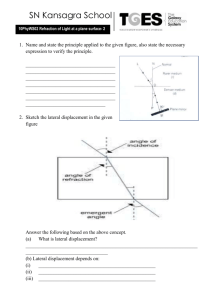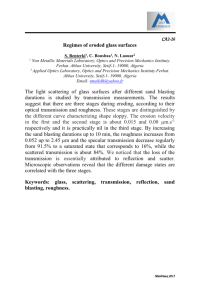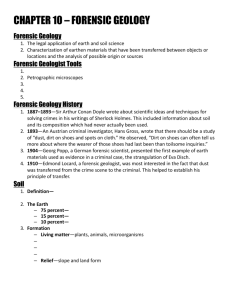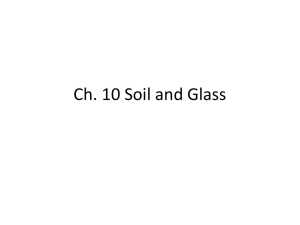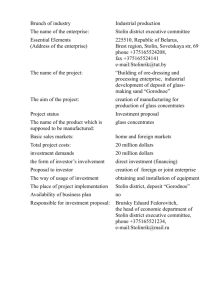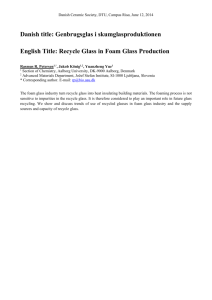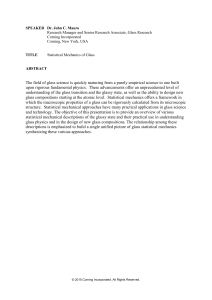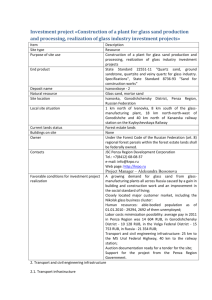Chapter 10 Checkpoint Questions 1. Consider what indicators might
advertisement
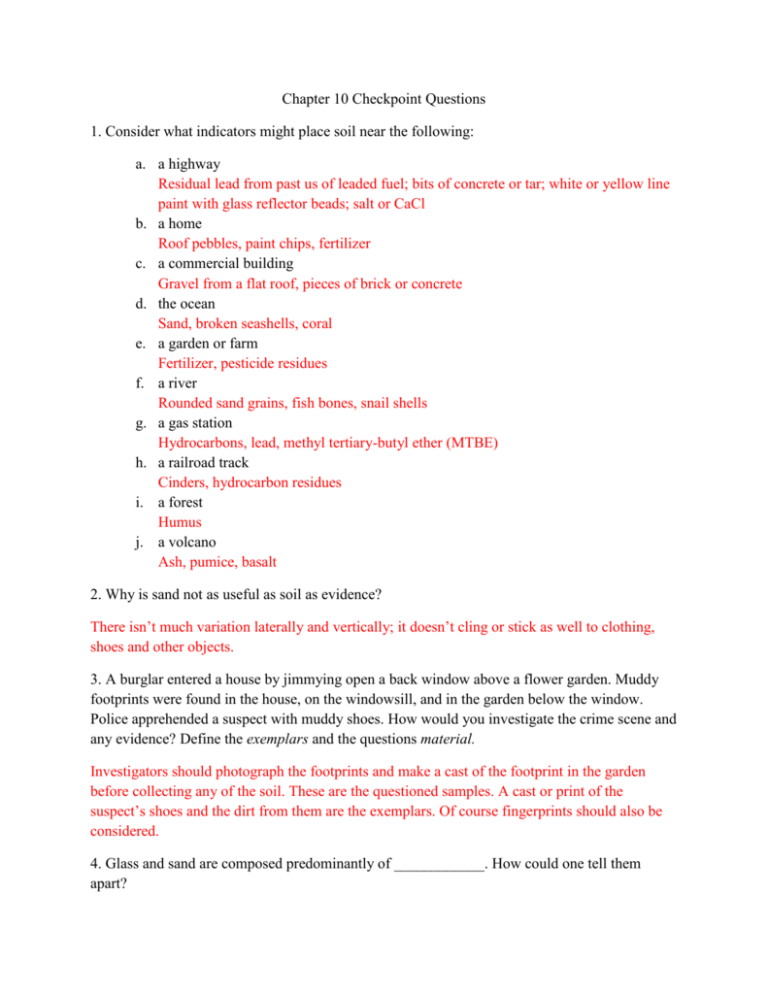
Chapter 10 Checkpoint Questions 1. Consider what indicators might place soil near the following: a. a highway Residual lead from past us of leaded fuel; bits of concrete or tar; white or yellow line paint with glass reflector beads; salt or CaCl b. a home Roof pebbles, paint chips, fertilizer c. a commercial building Gravel from a flat roof, pieces of brick or concrete d. the ocean Sand, broken seashells, coral e. a garden or farm Fertilizer, pesticide residues f. a river Rounded sand grains, fish bones, snail shells g. a gas station Hydrocarbons, lead, methyl tertiary-butyl ether (MTBE) h. a railroad track Cinders, hydrocarbon residues i. a forest Humus j. a volcano Ash, pumice, basalt 2. Why is sand not as useful as soil as evidence? There isn’t much variation laterally and vertically; it doesn’t cling or stick as well to clothing, shoes and other objects. 3. A burglar entered a house by jimmying open a back window above a flower garden. Muddy footprints were found in the house, on the windowsill, and in the garden below the window. Police apprehended a suspect with muddy shoes. How would you investigate the crime scene and any evidence? Define the exemplars and the questions material. Investigators should photograph the footprints and make a cast of the footprint in the garden before collecting any of the soil. These are the questioned samples. A cast or print of the suspect’s shoes and the dirt from them are the exemplars. Of course fingerprints should also be considered. 4. Glass and sand are composed predominantly of ____________. How could one tell them apart? Silicon dioxide or silica. Glass is amorphous; sand may be mostly quartz, which is crystalline and, therefore, birefringent 5. Would a body decay faster if buried in the A and upper B horizon, or in the lower B and upper C horizon? A and B because these layers have more organisms to eat the body 6. Taxonomy is the science of classification. A hierarchical organization system arranges item into groups with common properties for use in making comparison, establishing relationships, and managing and locating data. For example, the Henry-FBI system is used to classify fingerprints; chemistry has many classification systems, the periodic table being the most fundamental, Linnaeus worked out an extensive system of classification for plants and animals. What other systems can you think of? The mail system first sorting by zip code, then street, then house number; or a family genealogical tree. Is there such a classification system for soils? If so, describe it. For the thousands of types of soils, there is a classification system, generally described in any Earth science text. 7. Here is a “back-of-an-envelope-calculation”: How many grains of 40 mesh sand are there in one cubic foot of dry beach sand, assuming a 25 percent pore volume? There are 2.54 cm per inch, so 2.54x12=1ft; so a cubic foot = (2.54x12)3cc. Multiply by 1000 to convert to cubic millimeters. A grain of sand on the 40 mesh screen has a diameter of 0.425mm. The volume of a sphere is 4/3π3, so 4/3 X π X (0.21)3mm X 1.25= 0.048mm3. the 1.25 accounts for the added 25 percent pore volume, or packing efficiency. Doing the arithmetic gives about 6 X 108 grains of sand. How much would one cubic foot weigh? Knowing the sample weight, calculate the density and multiply by the volume of a cubic foot. Would one cubic foot of 40 to 100 mesh beach sand weigh more, the same, or less? The 40 to 100 mesh should be heavier. Why? It packs better. 8. You are on the stand as an expert witness on the comparative analysis of glass fragment. You must define and explain to the jury (generally consider a jury to have the equivalent of a seventhgrade level of understanding) the following terms: a. fluorescence Absorption of light of a shorter wavelength, then reemission at a longer wavelength b. density and specific gravity Density is mass per unit volume; the ratio of a substance’s density to that of water is its specific gravity c. reflection and refraction Reflection occurs when light bounces off a shiny surface such as a mirror. Refraction is the bending d. refractive index The ratio of the speed of light in a vacuum to its speed in a specified substance e. glass and how it is made Glass is a substance made from mostly silica, like very pure sea sand, that has been melted and had some chemicals added, then was formed into different shapes by heat. f. Becker line The light halo around each piece of a material immersed in a substance when determining refractive index g. class evidence Evidence that cannot be traced with certainty to an individual h. the circumstances under which glass evidence can be individualized If the pieces can be fitted together to form a match, as in a jigsaw puzzle, the evidence can be individualized 9. How are layer of dirt related, in a general sense, to layer of paint from a vehicle? The more layers, the more individual the story the material tells 10. What are the similarities in the physical property of amorphous and isotopic substances? Structurally, how do they differ? Amorphous and isotropic substances show the same properties in all directions; amorphous substances are noncrystalline, but an isotropic substance can be crystalline 11. How would you “calibrate” a density solution or column? By adding crystals of known density; see Table 10.3 on page 291 for examples. 12. Density and refractive index seem to be proportionally related. Why? The more dense an object is, the more interaction with light rays 13. Does a Galileo thermometer work? By buoyancy and the relationship between density and temperature 14. You used the flotation method to find a material’s density. Is there another method for determining density? Archimedes’ principle and buoyancy. Would it work here? No, the sample is too small. 15. What would weaken your argument that glass fragments from the suspect and from the crime scene appear to have a common origin? Lack of precision of analytical results; variability within small samples; many random samples have the same values 16. How would you differentiate among fragments of clear polystyrene, glass, and quartz? Glasses are isotropic, that is, their properties are the same in all directions. Most crystalline substances are anisotropic. The refractive index of silica glass (SiO2) is the same in all directions (n= 1.458), whereas natural quartz (siO2) has two indices of refraction (n=1.544 and 1.553). The difference between the two indices of refraction in the quartz is termed birefringence. When glass is rotated between crossed polarizing filters, no light is transmitted. When quartz is rotated under the same conditions, a point is reached when light will pass through the crystal. Tempered auto glass is birefringent because by being slowly cooled during manufacture, it crystalizes and, therefore, fractures into many small pieces. Polystyrene also exhibits birefringence, and its density is less than 1.
